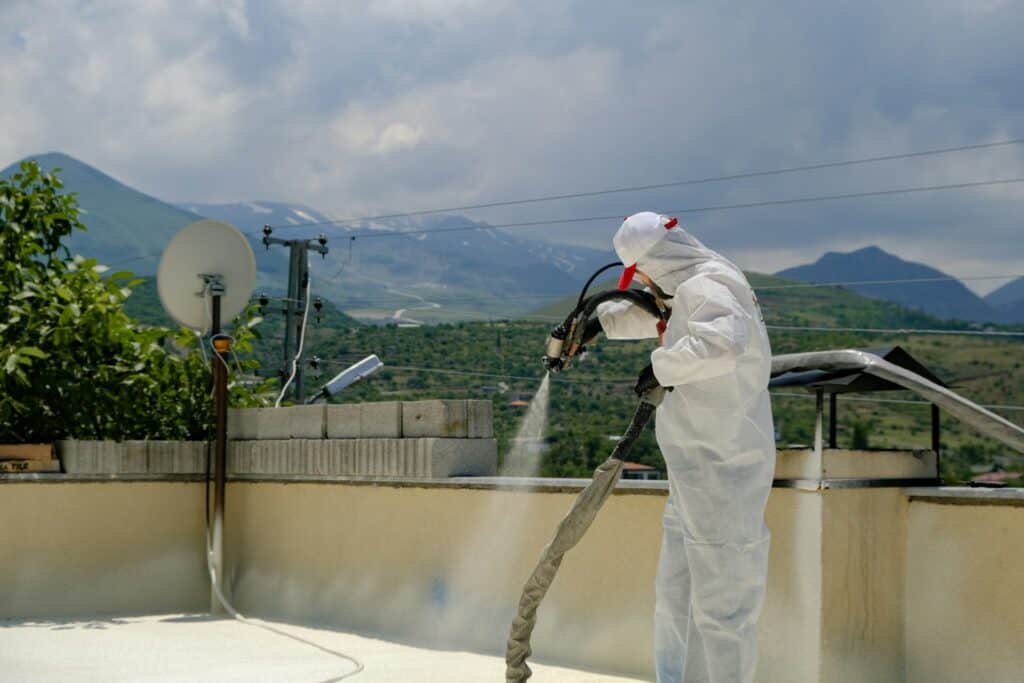Spray Polyurethane Foam Roofing: The Ultimate Commercial Roofing Solution
When it comes to commercial roofing, few materials can match the durability and efficiency of spray polyurethane foam (SPF). SPF roofing systems offer superior insulation and waterproofing, making them one of the top choices for energy efficiency and comfort. This guide will help facility managers and property owners understand the benefits of SPF and how it works.

What Is Spray Polyurethane Foam?
SPF is created by mixing two chemicals—Isocyanate (A) and polyol (B)—under heat and pressure, forming a solid, lightweight, and highly adherent roofing membrane. While SPF has been around since the 1940s, it gained popularity in the late 1970s for its excellent insulation properties in roofing and construction.
There are two types of SPF: closed-cell and open-cell foam. Closed-cell is primarily used for commercial roofing because of its strength, while open-cell is better suited for indoor insulation and soundproofing.
How SPF Roofing Works
SPF roofing is applied on-site using specialized spray equipment. The two components (A and B) are pumped through heated, high-pressure hoses and mixed right before application. The foam is then sprayed onto the roof surface, where it expands and hardens into a seamless, lightweight, and waterproof membrane. SPF also boasts the highest R-value of any commercial roofing material, meaning it provides top-notch thermal resistance, making it ideal for all climates.
Understanding Foam Density
For SPF to be strong enough for commercial use, it needs to have a density of at least 2.7 to 3 pounds per square foot—anything less, and it may not hold up under foot traffic. If the foam is too soft, it can be easily damaged when walked on.
The Importance of UV Protection
While SPF offers excellent insulation and waterproofing, it needs protection from the sun’s ultraviolet (UV) rays. To prevent degradation, an elastomeric roof coating, such as silicone, acrylic, urethane, or butyl rubber, is applied over the foam. This coating shields the SPF from harmful UV exposure.

Choosing the Right Contractor
SPF roofing requires specialized equipment and expertise, so choosing the right contractor is crucial. Look for professionals with extensive experience and proper certifications and ask for references and case studies. A well-installed SPF roof can last 30 to 40 years with regular maintenance, but it’s important to recoat it every 10 to 15 years to keep the system in top shape.
Advantages of SPF Roofing
- Unmatched Insulation: SPF has the highest R-value of any roofing material, making it incredibly energy efficient.
- Strength and Durability: A layer of SPF as thin as 1 inch can improve a building’s structural integrity while remaining lightweight.
- Longevity: Properly maintained, SPF roofs can last several decades, and with periodic recoating, they may be the only roof your building ever needs.
- Seamless Protection: Because SPF forms a seamless membrane, it eliminates common weak points like seams, fasteners, and joints where water typically infiltrates.
- Quick Installation: SPF systems can be installed faster than many traditional roofing materials and typically don’t require removing the existing roof.
- Sustainable: SPF roofing is eco-friendly, producing little to no waste throughout its lifespan, as the foam can be renewed without tearing off old material.
Disadvantages of SPF Roofing
- High Initial Costs: The specialized equipment needed for SPF installation is expensive, with complete rigs costing over $100,000. Maintenance can also be costly if parts are difficult to obtain.
- Vulnerability to UV: Without proper recoating, SPF can degrade under UV exposure, leading to potential system failures.
- Overspray Concerns: The foam’s adhesive properties can cause overspray on nearby objects, especially on windy days. Contractors may use wind shields to control this, but it’s still a risk to surrounding property.
SPF Installation Process
The installation of an SPF roof typically follows these steps:
- Surface Preparation: The existing roof is cleaned with a pressure washer to remove debris. A primer may also be applied for better foam adhesion.
- Foam Application: SPF is sprayed onto the roof at a minimum thickness of 1 inch, with additional thickness added in areas requiring better drainage or insulation.
- Coating: A protective elastomeric coating is applied to prevent UV damage. Depending on the roof’s slope, either silicone, acrylic, or urethane is used.
- Granules Application: Finally, roofing granules are broadcast into the top coating for added protection against UV rays and wear.

Long-Term Maintenance
Like any commercial roof, SPF roofs require regular maintenance. It’s essential to inspect the roof in spring and fall and after major weather events. Small issues, like punctures or UV-damaged foam, should be addressed promptly to prevent larger problems down the line. If the foam is compromised, repairs may involve removing damaged sections and recoating the surface.
Final Thoughts
Spray polyurethane foam is a top-tier material for modern commercial roofing, offering unmatched insulation, durability, and longevity. With proper installation and routine care, an SPF roofing system may be the last roof your building will ever need, delivering a great return on investment through energy savings and reduced maintenance costs.
